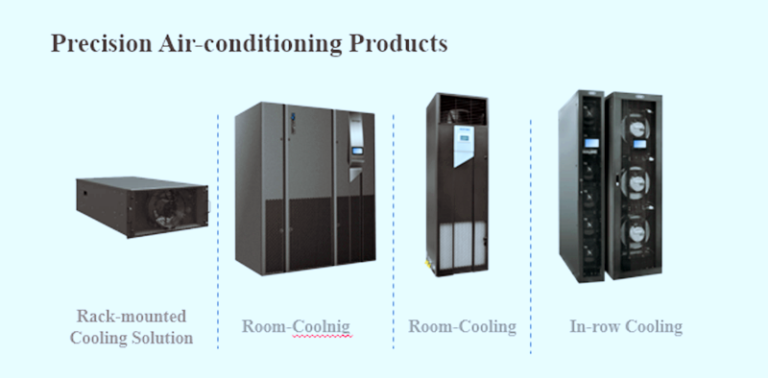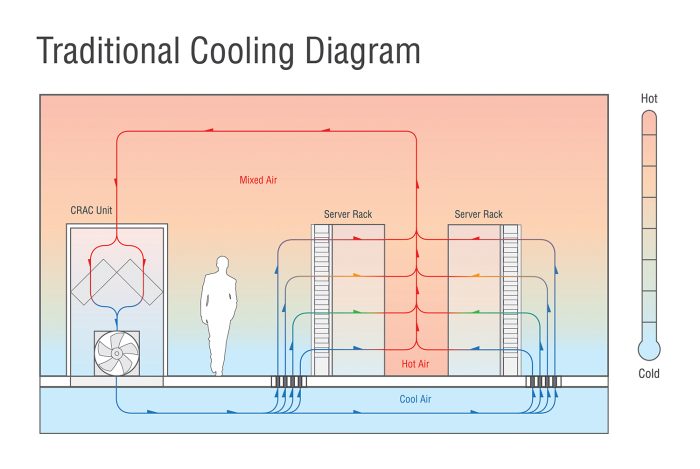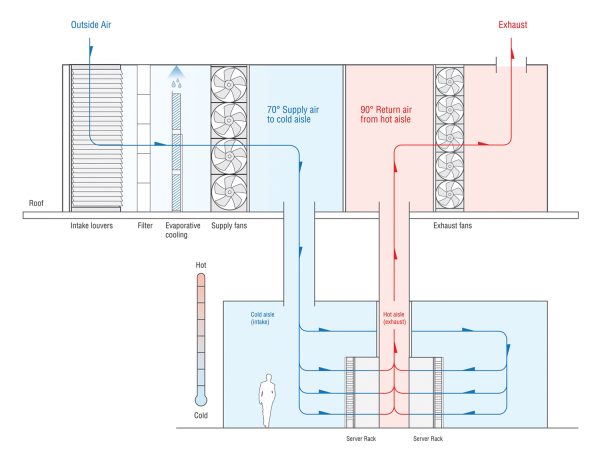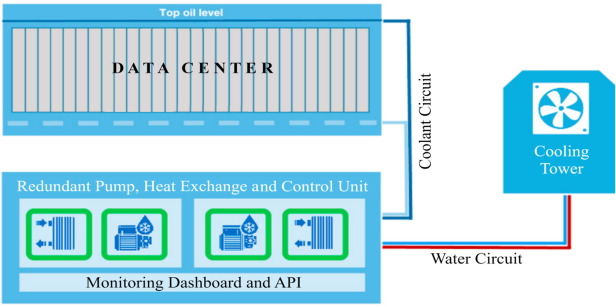Data Center Cooling
In the rapidly expanding digital world, data centers stand as the backbone of the internet, housing the critical infrastructure that powers our daily online activities. However, this immense computational power comes with a significant challenge: heat.
In the complex design of servers and networks, cooling technologies emerge as critical players, tasked with the vital role of mitigating heat to maintain operational efficiency and prevent potential system failures.
When we look at the data center landscape, we can see that a lot has changed. If 2020, the COVID pandemic year has taught us anything, it is that our digital infrastructure is more important than ever. Cloud computing, big data, IT infrastructure, power, and cooling efficiency all have new demands. More users, more data, and a greater reliance on the data center are driving forces. Working with the correct data center optimization solutions has become more important than ever with cloud technologies and the rapid growth of data leading the way in many technological categories.
The Dawn of Data Center Cooling Technologies
The journey of cooling technologies in data centers began with simple air conditioning units or CRAC (Computer Room Air Conditioner) units, primarily focused on keeping the environment within manageable temperatures.
As the industry evolved this method, suitable for lower compute densities, soon showed its limitations with the advent of higher-density setups. Issues such as temperature stratification and inefficient air mixing led to the development of containment strategies and raised floor systems designed to strategically direct cool air through perforated tiles straight to the servers’ thirsting intakes. The era of precision cooling further refined the process, introducing Precision Air Conditioning (PAC) units that offered meticulous control over temperature and humidity, marking a significant leap toward targeted cooling solutions.
Data Center Cooling Methods and Systems
Modern data centers handle a wide range of traffic, enabling everything from financial transactions to social media interactions. As this demand means data centers grow in scale and complexity, the importance of efficient cooling solutions intensifies.
There are several common cooling methods in use today. Ensuring these systems are efficient, reliable, and sustainable is perhaps the key challenge for data center providers.
Cooling a data center typically takes a lot of energy (>50% depending on location and design) and a lot of planning. Traditionally, there are three different ways to cool a datacenter:
- Air-based cooling,
- Liquid-based cooling
- Hybrid of the two
Air-based Cooling
The cold aisle/hot aisle method:
This method focuses on separating the cold air from the hot air by facing the cold sides of the server away from the hot sides producing a convection system. This method isn’t the most effective, as it forces data center managers to push more cold air into the room.
The cold or hot air containment method:
This method takes the previous method and tries to improve it by physically containing the servers, so the hot and cold air don’t mix. This method works better than the cold aisle/hot aisle method, but data centers still experience hot spots.
The in-rack heat extraction method:
This method eliminates the hot air by adding a compression cooler built into the server rack.
Advantages of air cooling in data centers:
- Generally reliable performance levels and suitable for various data center types
- Proven technology with a history of effective air temperature management
- Easily implemented in both small and large-scale facilities
Disadvantages of air cooling in data centers:
- Potential for high energy consumption, especially for facilities in warmer climates
- Dependence on airflow can cause fluctuations in energy usage
- Can bring high energy costs if not managed effectively
Liquid-based- Based Cooling
When it comes to liquid-based cooling systems, it is necessary to distinguish between water, synthetic fluid, and mineral coolant.
Water-cooled racks
(otherwise known as rear-door chillers) have water flowing alongside the racks, but never actually touching the servers.Direct liquid cooling
mostly refers to water or other liquids that are delivered directly to a hot plate which is only on CPUs and GPUs, dealing with 70% of the heat.
With rear door cooling and direct liquid cooling, it is normally advised to have a secondary form of cooling such as a traditional CRAC unit to handle the excess heat in the room.
Liquid Immersion Cooling
means that the entire servers (switches, etc.) are completely submerged in a synthetic or mineral fluid, designed to deal with 100% of the heat and preserve the IT Hardware (no particles being shot) and is the most efficient method to save energy if combined with dry coolers (with or without adiabatic functionality) using only ambient temperatures to lower the warm water of the secondary cooling loop.
Advantages of liquid cooling in data centers:
- Can typically offer superior heat removal compared to air cooling
- Uses the conductive properties of liquids to quickly move heat away from servers
- Particularly effective for high-power density facilities
- Direct cooling can allow for highly efficient temperature management
- Reduces the reliance on other cooling infrastructures like fans
- Has the potential for significantly reduced energy consumption
Disadvantages of liquid cooling in data centers:
- Can use vast amounts of the local water supply.
- Coolant leaks can be environmentally unfriendly if not addressed properly
- Complex to set up and can have several potential points of failure
- Might not be suitable for all types of data centers
- Brings potential risks associated with leaks
- Costly and tricky to implement
Current Trends in Data Center Cooling
Today’s cooling landscape is characterized by a heightened emphasis on energy efficiency, driven by the need to curtail power consumption without compromising on performance. Liquid cooling has risen to prominence, celebrated for its exceptional ability to dissipate heat and support denser computing configurations. The innovation doesn’t stop there; containment systems have been devised to segregate hot and cold airflows, enhancing the efficacy of cooling mechanisms and setting new standards in energy optimization.
The Age of Precision Cooling
As data centers grew in density and complexity, the need for more precise and efficient cooling methods became apparent. Enter in-row cooling units with variable speed fans, offering targeted cooling and significantly reduced energy consumption compared to their predecessors. This marked a significant leap toward achieving lower PUE (Power Usage Effectiveness) ratings and more sustainable operations.

Harnessing the Power of Economizers
The quest for efficiency brought economizers into the spotlight, utilizing outside air to aid in cooling and significantly reducing energy consumption. Geographic location plays a crucial role here, with cooler climates offering a natural advantage. Yet, the reliance on external conditions highlighted the need for even more innovative and adaptable solutions.
The Promise of Immersion Cooling
Immersion cooling is a method of cooling electronic devices by submerging them in a non-conductive liquid, such as mineral oil or de-ionized water. The liquid absorbs heat from the devices and transfers it to the environment through a heat exchanger.
Immersion cooling is more efficient than traditional air cooling because the liquid can absorb more heat and transfer it away from the devices more quickly. This can lead to lower operating temperatures and increased performance for the devices.
This technique offers superior heat removal efficiency and opens the door to potentially achieving near-perfect PUE ratings. It’s a testament to the industry’s commitment to pushing the boundaries of cooling technology.
Benefits of immersion cooling:
- Increased efficiency: Immersion cooling can transfer heat away from devices more quickly than air cooling, which can lead to lower operating temperatures and increased performance.
- Reduced noise: Immersion cooling eliminates the need for fans, which can make data centers much quieter.
- Reduced fire risk: Immersion cooling fluids are typically non-flammable, which can help to reduce the risk of fires in data centers.
- Improved reliability: Immersion cooling can help to protect devices from dust and moisture, which can improve their reliability.
Immersion cooling is a promising technology that has the potential to improve the efficiency, performance, and reliability of data centers.
Towards a Greener Future: Fresh Air Cooling and Beyond
The pursuit of sustainability has led to the exploration of fresh air cooling, which, despite its challenges with humidity and dust, offers a path to drastically lower PUEs. Moreover, the integration of data centers with district heating and cooling systems exemplifies a holistic approach to utilizing waste heat, further contributing to a more sustainable ecosystem.
The Future of Data Center Cooling
As we look ahead, the future of cooling technologies holds boundless potential, with smart cooling systems poised to redefine efficiency through the adept use of AI and machine learning. The integration of renewable energy sources paves the way for a future where data centers not only power the digital world but do so in harmony with the environment.
The evolution of data center cooling technologies is a testament to the industry’s resilience and ingenuity. From the basic air cooling methods of the past to the sophisticated liquid and immersion cooling solutions of today, the journey towards more efficient and sustainable data centers continues.




